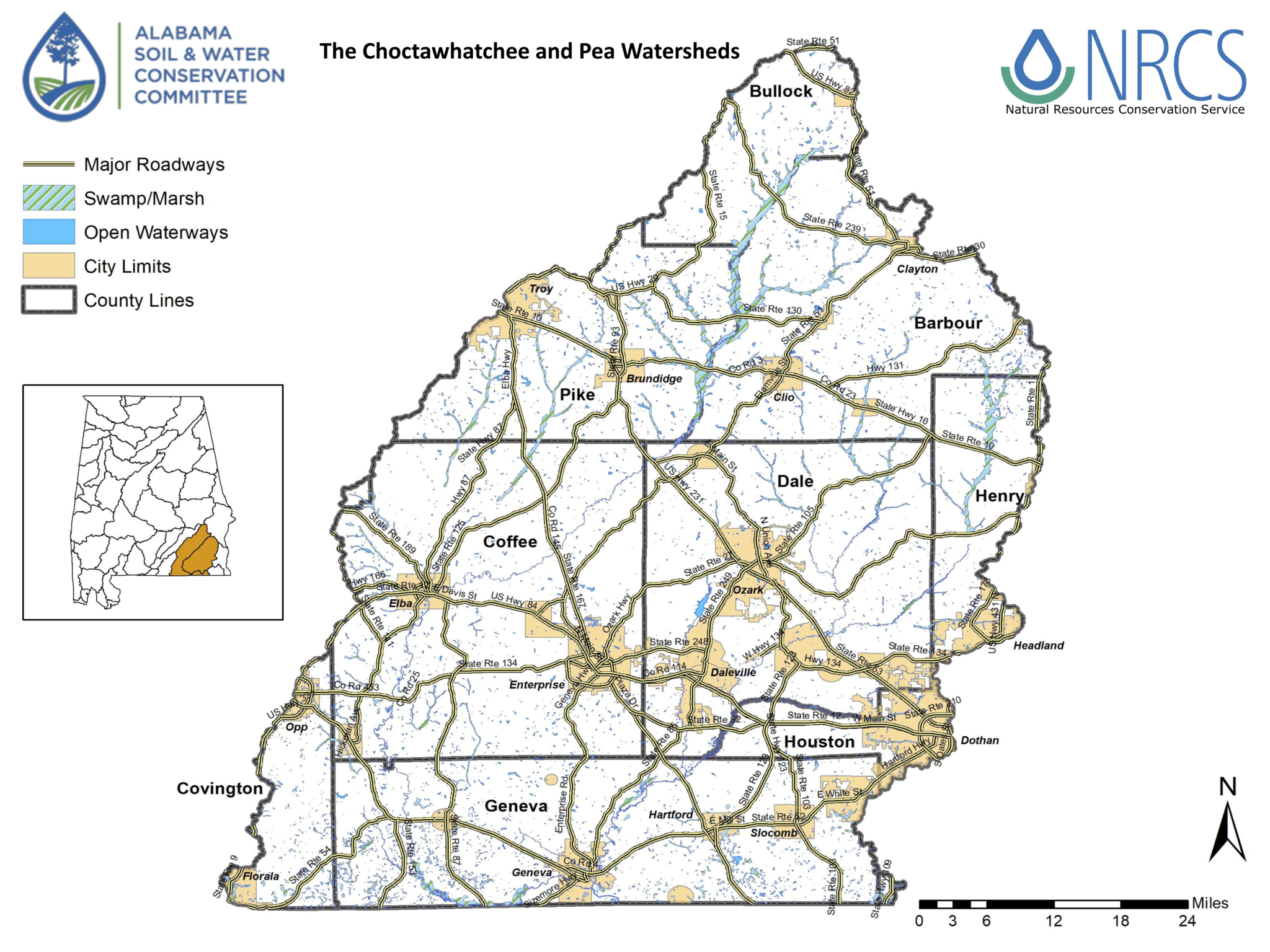Watershed Planning

About the Choctawhatchee-Pea Basin
Agriculture in the Choctawhatchee-Pea (Choc-Pea) Basin encompasses 1,988,597 acres. It includes portions of Barbour, Bullock, Coffee, Covington, Dale, Geneva, Henry, Houston, and Pike Counties in southeast Alabama. The boundary of the Choc-Pea Basin comprises one of the largest agricultural regions in Alabama. Row crop agriculture ranks as the dominant source of agriculture income for the area, in addition to beef cattle operations and poultry production.
The Choctawhatchee River originates as two separate forks (East Fork and West Fork) in wetlands near Clayton in Barbour County. Near Ozark in central Dale County, the forks merge to form the Choctawhatchee River. The Choctawhatchee River is the longest free-flowing river remaining in Alabama at 170 miles. Its main tributary, the Pea River, joins the Choctawhatchee just below Geneva near the Florida state line.
Watershed Plan – Environmental Assessment Status
A Final Watershed Plan – Environmental Assessment (Plan-EA) and a Finding of No Significant Impact (FONSI) for the Sustainable Irrigation Expansion Project in the Choc-Pea Basin have been released. The USDA Natural Resources Conservation Service (NRCS) determined that the project will not cause significant local, regional, or national impacts to the environment.
A Watershed Plan – Environmental Assessment (Plan-EA) was developed for the Choc-Pea Basin to fulfill requirements of the National Environmental Policy Act (NEPA) and to be considered for authorization of Public Law 83-566 (PL-566) funding for irrigation expansion within the basin. The Irrigation Watershed Planning Project (IWP) benefits rural communities by reducing damage to crops, improving soil health, and protecting basin water quality through sustainable irrigation expansion while minimizing environmental and cultural resources impacts.
Using the Plan-EA, the Alabama Soil and Water Conservation Committee (ALSWCC) will identify farms eligible to receive cost-share funds for irrigation infrastructure.
Process
In August 2019, NRCS and project partners held a farmer scoping meeting to identify farmer needs in the Choc-Pea Basin. Comments received during this meeting aided in the development of the Draft Watershed Plan-EA.
The technical team from Auburn University and the University of Alabama in Huntsville prepared the Preliminary Investigation and Feasibility Report.
On February 11, 2021, a Draft Plan-EA was released. Comments were accepted from January 29, 2021, to March 9, 2021. A public meeting was held on February 26, 2021 through Zoom to discuss the Draft Plan-EA and accept public comments. The Draft Plan-EA identifies potential alternatives to meet the project’s purpose and need, identifies the resources potentially affected by the project, and evaluates the effects of the project on those resources.
Comments received during this period were evaluated and incorporated into a Final Plan-EA. The NRCS released a Finding of No Significant Impact (FONSI) for the Choctawhatchee-Pea Sustainable Irrigation Expansion Project on November 5, 2021.
With a completed environmental assessment in place, the project is now eligible for federal funding and may move forward into implementation.
Project Documents
Final ChocPea_Plan-EA 11-5-2021
Final ChocPea_Appendices_11_5_2021
Choctawhatchee-Pea Finding of No Significant Impact
For additional information about the Irrigation Watershed Planning Program, contact:
IWP@auburn.edu or call 334-844-3809
Sign up to stay informed about this project and future projects.

